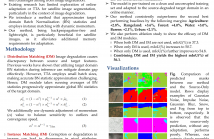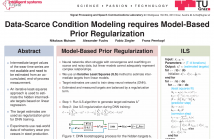- Bayesian learning; Bayesian signal processing (MLR-BAYL)
- Bounds on performance (MLR-PERF)
- Applications in Systems Biology (MLR-SYSB)
- Applications in Music and Audio Processing (MLR-MUSI)
- Applications in Data Fusion (MLR-FUSI)
- Cognitive information processing (MLR-COGP)
- Distributed and Cooperative Learning (MLR-DIST)
- Learning theory and algorithms (MLR-LEAR)
- Neural network learning (MLR-NNLR)
- Information-theoretic learning (MLR-INFO)
- Independent component analysis (MLR-ICAN)
- Graphical and kernel methods (MLR-GRKN)
- Other applications of machine learning (MLR-APPL)
- Pattern recognition and classification (MLR-PATT)
- Source separation (MLR-SSEP)
- Sequential learning; sequential decision methods (MLR-SLER)

- Read more about J-MAE: Jigsaw Meets Masked Autoencoders In X-Ray Security Inspection
- Log in to post comments
The X-ray security inspection aims to identify any restricted items to protect public safety. Due to the lack of focus on unsupervised learning in this field, using pre-trained models on natural images leads to suboptimal results in downstream tasks. Previous works would lose the relative positional relationships during the pre-training process, which is detrimental for X-ray images that lack texture and rely on shape. In this paper, we propose the jigsaw style MAE (J-MAE) to preserve the relative position information by shuffling the position encoding of visible patches.
- Categories:
 10 Views
10 Views
- Read more about BRAIN STRUCTURE-FUNCTION INTERACTION NETWORK FOR FLUID COGNITION PREDICTION
- Log in to post comments
Predicting fluid cognition via neuroimaging data is essential for understanding the neural mechanisms underlying various complex cognitions in the human brain. Both brain functional connectivity (FC) and structural connectivity (SC) provide distinct neural mechanisms for fluid cognition. In addition, interactions between SC and FC within distributed association regions are related to improvements in fluid cognition. However, existing learning-based methods that leverage both modality-specific embeddings and high-order interactions between the two modalities for prediction are scarce.
- Categories:
 26 Views
26 Views
- Read more about Federated PAC-Bayesian Learning on Non-IID Data
- Log in to post comments
Existing research has either adapted the Probably Approximately Correct (PAC) Bayesian framework for federated learning (FL) or used information-theoretic PAC-Bayesian bounds while introducing their theorems, but few consider the non-IID challenges in FL. Our work presents the first non-vacuous federated PAC-Bayesian bound tailored for non-IID local data. This bound assumes unique prior knowledge for each client and variable aggregation weights. We also introduce an objective function and an innovative Gibbs-based algorithm for the optimization of the derived bound.
- Categories:
 13 Views
13 Views
- Read more about Unsupervised Continual Learning of Image Representation via Rememory-based SimSiam
- Log in to post comments
Unsupervised continual learning (UCL) of image representation has garnered attention due to practical need. However, recent UCL methods focus on mitigating the catastrophic forgetting with a replay buffer (i.e., rehearsal-based strategy), which needs much extra storage. To overcome this drawback, we propose a novel rememory-based SimSiam (RM-SimSiam) method to reduce the dependency on replay buffer. The core idea of RM-SimSiam is to store and remember the old knowledge with a data-free historical module instead of replay buffer.
- Categories:
 11 Views
11 Views
- Read more about BigVSAN: Enhancing GAN-based Neural Vocoders with Slicing Adversarial Network
- Log in to post comments
Generative adversarial network (GAN)-based vocoders have been intensively studied because they can synthesize high-fidelity audio waveforms faster than real-time. However, it has been reported that most GANs fail to obtain the optimal projection for discriminating between real and fake data in the feature space. In the literature, it has been demonstrated that slicing adversarial network (SAN), an improved GAN training framework that can find the optimal projection, is effective in the image generation task. In this paper, we investigate the effectiveness of SAN in the vocoding task.
- Categories:
 19 Views
19 Views
- Read more about Source-Free Online Domain Adaptive Semantic Segmentation of Satellite Images under Image Degradation
- Log in to post comments
Online adaptation to distribution shifts in satellite image segmentation stands as a crucial yet underexplored problem. In this paper, we address source-free and online domain adaptation, i.e., test-time adaptation (TTA), for satellite images, with the focus on mitigating distribution shifts caused by various forms of image degradation. Towards achieving this goal, we propose a novel TTA approach involving two effective strategies. First, we progressively estimate the global Batch Normalization (BN) statistics of the target distribution with incoming data stream.
ICASSP_24__final.pdf
- Categories:
 20 Views
20 Views
- Read more about DATA-SCARCE CONDITION MODELING REQUIRES MODEL-BASED PRIOR REGULARIZATION
- Log in to post comments
In the metallurgical industry, taking measurements during production can be infeasible or undesired, and only the terminated process can be measured. This poses problems for regression models, as the intermediate target values for a time series are hidden in the accumulated end-of-process measurement. The lack of data quality and quantity also often limits the modeling to linear estimators, as neural networks struggle to converge and/or overfit on scarce noisy data.
- Categories:
 24 Views
24 Views
- Read more about Convolutional Filters and Neural Networks with Non Commutative Algebras
- Log in to post comments
In this paper we introduce and study the algebraic generalization of non commutative convolutional neural networks. We leverage the theory of algebraic signal processing to model convolutional non commutative architectures, and we derive concrete stability bounds that extend those obtained in the literature for commutative convolutional neural networks. We show that non commutative convolutional architectures can be stable to deformations on the space of operators.
- Categories:
 15 Views
15 Views
- Read more about Non Commutative Convolutional Signal Models in Neural Networks: Stability to Small Deformations
- Log in to post comments
In this paper we discuss the results recently published in [1] about algebraic signal models (ASMs) based on non commutative algebras and their use in convolutional neural networks. Relying on the general tools from algebraic signal processing (ASP), we study the filtering and stability properties of non commutative convolutional filters. We show how non commutative filters can be stable to small perturbations on the space of operators.
- Categories:
 13 Views
13 Views
- Read more about Hyperspectral Image Reconstruction using Hierarchical Neural Architecture Search from a Snapshot Image
- Log in to post comments
Hyperspectral imaging is a promising imaging modality, and has attracted increasing research attention by compressive sensing such as coded aperture snapshot spectral imaging (CASSI), for simultaneously capturing abundant information in spatial, spectral and temporal domains. Hyperspectral image (HSI) reconstruction in the CASSI aims to retrieve the original 3D signal upon the 2D compressed snapshot.
ID6267.pdf
- Categories:
 31 Views
31 Views